We spent the day in Belfast then drove to a hotel near Dublin. We walked around Belfast and visited The Titanic Experience. We highly recommend The Titanic Experience. I loved it! Michael thought it was good, but he hesitates to use the “L-word.”
We all know the story of the Titanic and its climactic ending: it sank.
But there’s so much more!
There is a lot of detail and content in this post (equivalent to three posts) because I found the exhibit to be of utmost interest. Feel free to use the headings to decide which sections to read if you aren’t interested in all of it.
First, the walk to the exhibit.

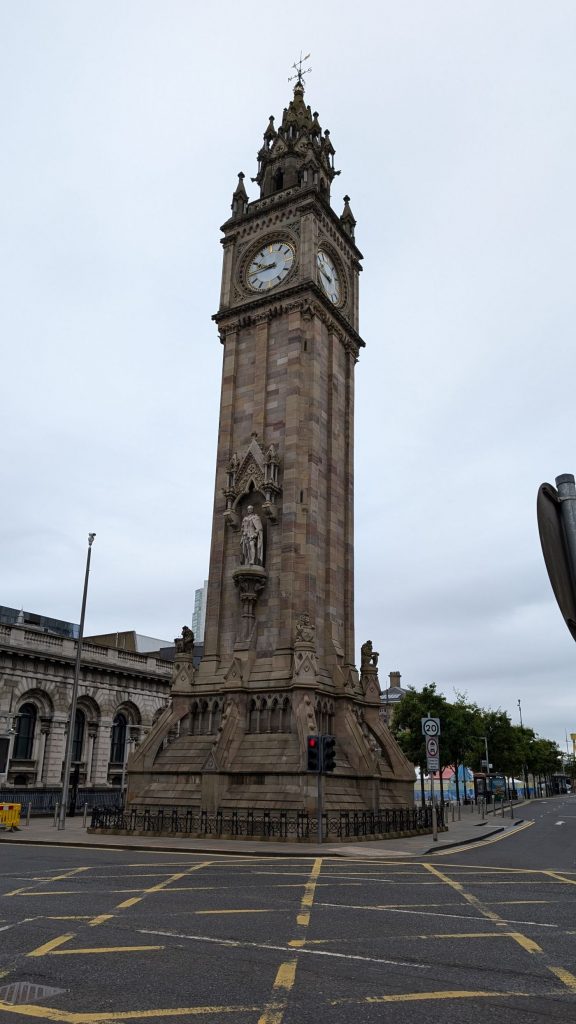

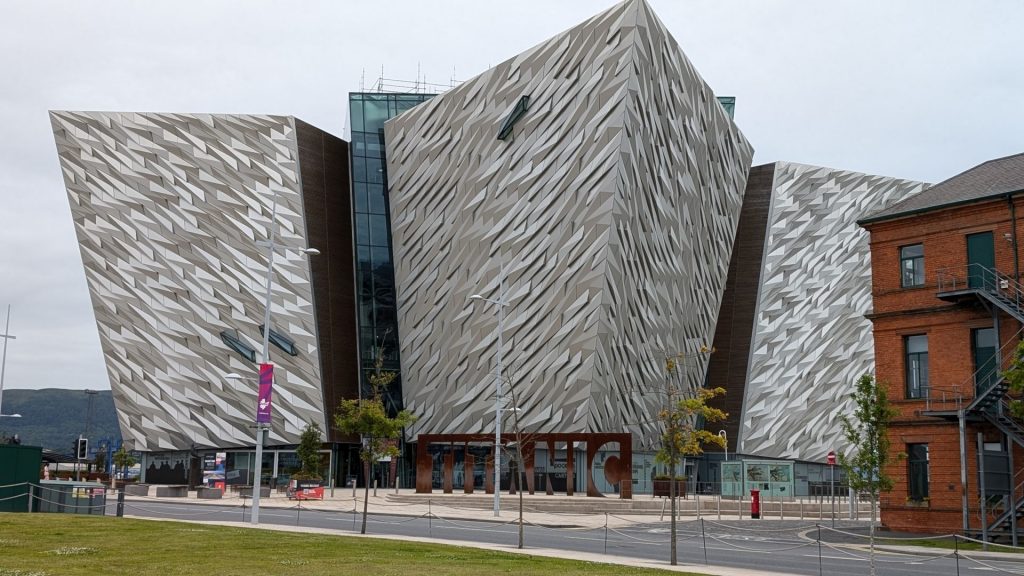


Here are some factoids explaining why the Titanic was built in Belfast.
— From the early 1600s Belfast had a port where the Lagan and Farset rivers met. The port became increasingly important for trade and by the 1700s was the leading port in the north of Ireland.
— The earliest record of ships being built in Belfast is from 1663.
— In 1785 the Ballast Board was established in Belfast to manage and develop the harbor.
— Shipbuilding as a major industry began in 1791 when William Ritchie established his works on the Lagan. At this time, ships were built from wood.
— In 1838, the first iron vessel was built in Belfast.
— The port needed to be expanded in the mid 1800s. Queen’s Island (renamed the Titanic Quarter in 1995) was created in 1847 when slobs from the digging of Victoria Channel were deposited on the County Down side of the Lagan Estuary.
— In 1847, the Harbour Commissioners replaced the Ballast Board. Much of the success of the shipbuilding industry and trade through the port was due to the far-sighted Harbour Commissioners. The Harbour Commissioners still remain a powerful force in Belfast.
— Belfast was the fastest cargo discharging port in the world in 1907. At that time, there were over 6,000 people working as dockers and carters in Belfast’s ports.
— From the mid 1880s Harland and Wolff (headquartered in London) was the most important shipbuilding firm in the United Kingdom.
— While other shipbuilding firms in Britain were often constrained by lack of space, Queen’s Island (Belfast) offered Harland and Wolff the opportunity to expand.
— By 1900 the Harland and Wolff Queen’s Island site covered 80 acres and employed between 9,000 and 10,000 people. The type of ships that were built changed to take advantage of new technologies and the shipyard needed to constantly evolve to build these bigger and more advanced vessels. The yard was capable of constructing several ships simultaneously.
— As the years went by, Harland and Wolff were producing larger and increasingly complex vessels.
Emigration
In the first decade of the 20th century over eight million Europeans emigrated to North America. New York was the main gateway to a new life. Belfast grew rich building emigrant ships to ever higher standards. Third Class was replacing steerage and the days of the “coffin ships” were long gone. There were cabins rather than dormitories and toilet facilities were adequate. Emigrants no longer had to bring their own food as they were served a choice of plain fare in large, bare dining halls.
The two main competitors for the North Atlantic trade were the White Star Line, bought by American millionaire J Pierpont (J.P.) Morgan and his International Mercantile Marine (IMM) group in 1902, and the British-owned Cunard. The race to build larger, faster and more luxurious ships intensified with White Star’s ambitious plans to build three Olympic class ships. [Spoiler alert: one was Royal Mail Ship (RMS) Titanic]
It’s a go!
Harland and Wolff were given orders to proceed with the Olympic and Titanic on September 17, 1908. It took Harland and Wolff two years to complete all the alterations needed to accommodate the building of these massive new ships. Such as . . .
Four of the existing slips at Harland and Wolff were replaced by two much bigger slips over which the Arrol Gantry was constructed. The gantry was a massive overhead structure which carried a system of cranes and traveling frames. Electric elevators and walkways provided access to the ships and to the gantry itself. The gantry extended across the two slipways where both Olympic and Titanic would be built.
The gantry was almost 270 feet wide, 840 feet long and 228 feet high and consisted of three rows of 11 columns. The 6,000 ton steel structure could be seen from most areas of Belfast. The Arrol gantry was dismantled in the 1960s.
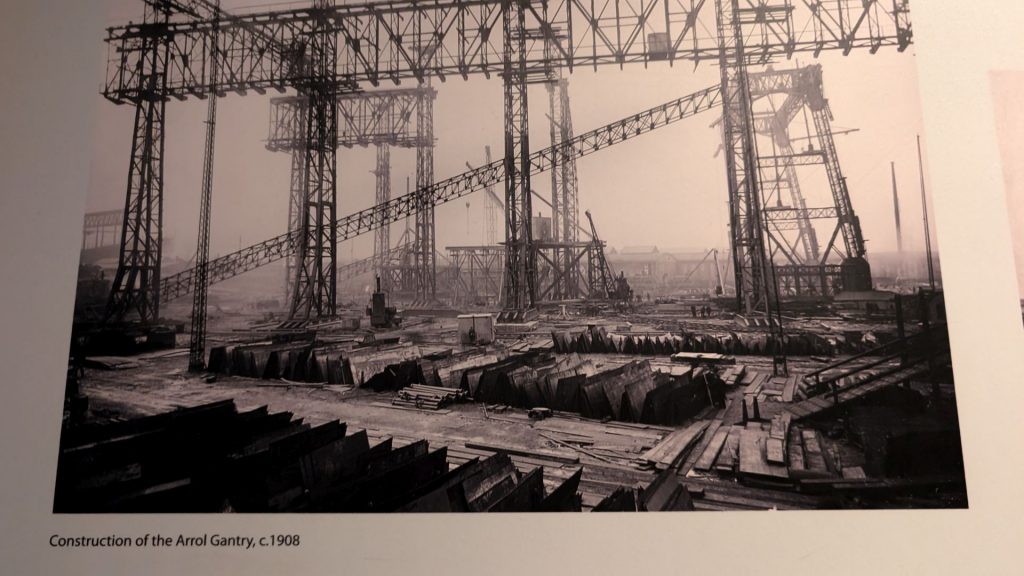

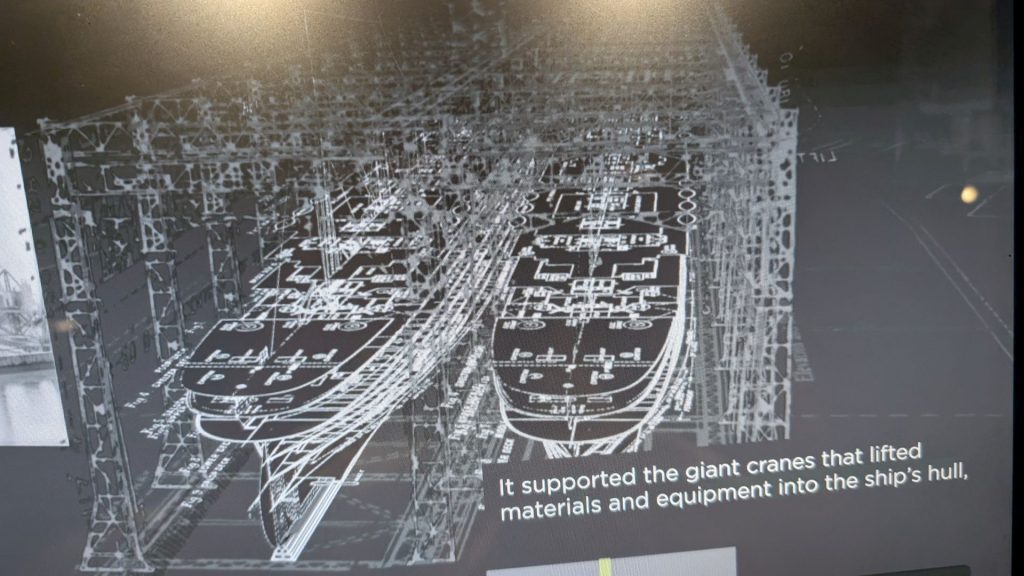
But that’s not all!
A new harbor crane was ordered for the fitting out berth. This was a 200 ton floating crane which was needed to lift heavy objects such as engines, boilers and funnels onto the Olympic class ships.
Alterations were not limited to Harland and Wolff. In the early 1900s the Harbour Commissioners had begun construction of the largest dry dock in the world. Thompson Dock was extended further for the Olympic class ships.
Ship design
The journey from design to construction was a complex one for the Olympic class ships. The ships were planned with a series of two-dimensional flat plans and three-dimensional models. (No computers at this time, of course.) Once completed, the designs were taken to the mould loft.
The mould loft was several hundred feet long and a hundred feet wide. On its floor, loftsmen would chalk the lines of the cross section of the ship at full-size and the length at quarter-scale. Any corrections were then updated on the plans. The loftsmen also made templates for all the structural parts of the ship.
Designers hard at work:

Design (gulp):

Let’s talk rivets!
The Titanic was held together by over three million rivets. Designers indicated in the plans where each and every rivet had to be placed.
The process of riveting was done both by hand and mechanically with hydraulic riveters. By hand: One boy heated the rivets in a fire; another boy passed the red-hot rivet to the “holder up.” The “holder up” held the rivet in place with a 13 pound hammer while two riveters struck the rivet in turn. The best teams used one left-handed and one right-handed riveter. A four-man crew could fit 200 rivets in one day. Had there just been one crew (there wasn’t), it would have taken them 15,000 days to install the over 3,000,000 rivets.
Here are some other facts about the riveting process on the Titanic:
- The hammers used for riveting ranged from 2 pounds to almost 40 pounds, depending on the size of the rivets and the type of work.
- A foreman would inspect the completed rivets at the end of the day to ensure they met the standard. If the rivet sounded hollow, the crew would have to redo it in their own time for free.
- The rivets used in the Titanic’s bow and stern were hand-forged from wrought iron (notably weaker than steel) instead of steel to save money and meet deadlines.


Laying the Keel – Titanic’s Spine
Titanic’s keel was laid on March 31, 1909 in slipway No. 3 underneath the Arrol Gantry.
Wooden blocks were laid on the slipway and the keel was built on these. Flat steel keel plates were laid on the blocks. The keel plate was strengthened on the bottom by a keel bar to protect the ship in the dry dock or if it ran aground. The vertical keel was fixed to the keel plates.
The Titanic was constructed with a double bottom. The outer steel plating bottom formed the skin of the ship. The vertical keel formed the center of the double bottom. The inner bottom plating formed a second skin. The double bottom formed a series of tanks used to store water for the boilers and ballast to weight the ship. The double bottom added to safety as the ship had two watertight skins.
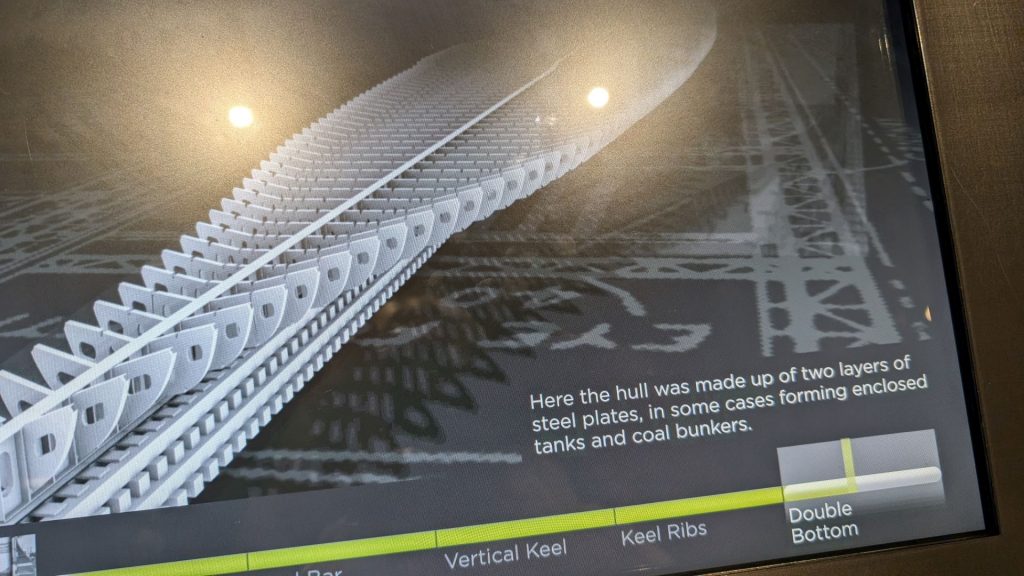

The Skeleton of Titanic
The frames were manufactured as straight bars, then bent and trimmed to size by frame benders at Harland and Wolff.
The frames were over 60 feet, weighed one ton and were positioned two to three feet apart along the length of the ship.
The keel of the ship was marked with the positions where the frames would go. They were then hoisted into position. Wooden shoring was placed within the framework of the ship to ensure correct spacing of the frames.
Deck beams were attached to the frames at each deck level and cross-beams and supporting pillars were also added. This secured the structure and the wooden shoring was then removed. The whole structure was held together by iron and steel rivets.
The framing, decks and beams reinforced the skeleton and added to the overall strength of the ship.
Titanic was fully framed by April 6, 1910.

More framing (below left).
The rudder (below right) was made in six pieces and then bolted together. The bolts were covered in cement to protect them from the corroding effects of sea water. The rudder was over 78 feet high with a maximum width of 15 feet and it weighed over 100 tons. The rudder frames had to be enormously strong to withstand the force of the rudder turning in heavy seas.

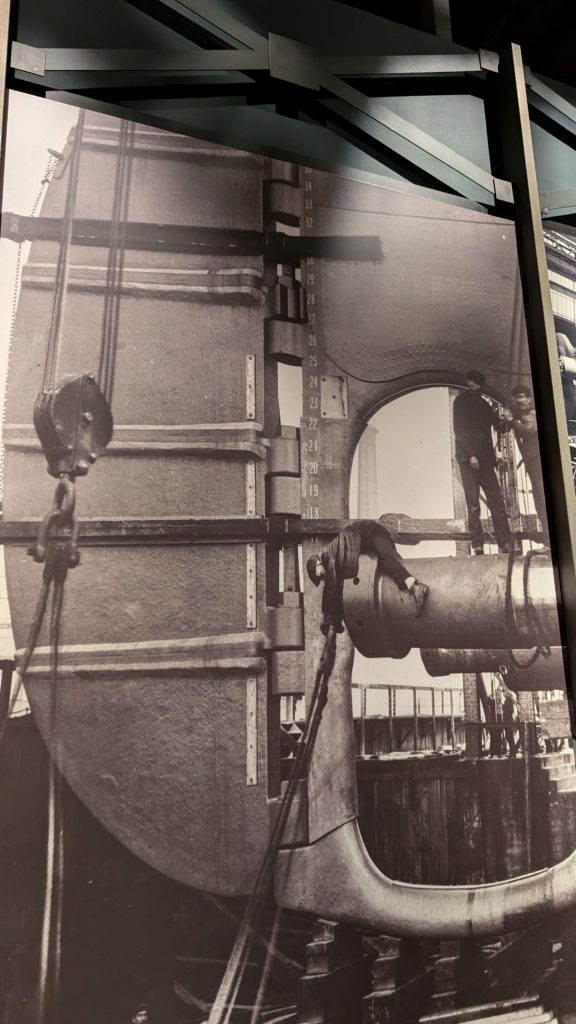
The outer propellers were held clear of the hull by propeller bosses. The three propellers were located at the stern of the ship (of course) with one at each side and one in the center. Each propeller was driven by one of the ship’s three engines.
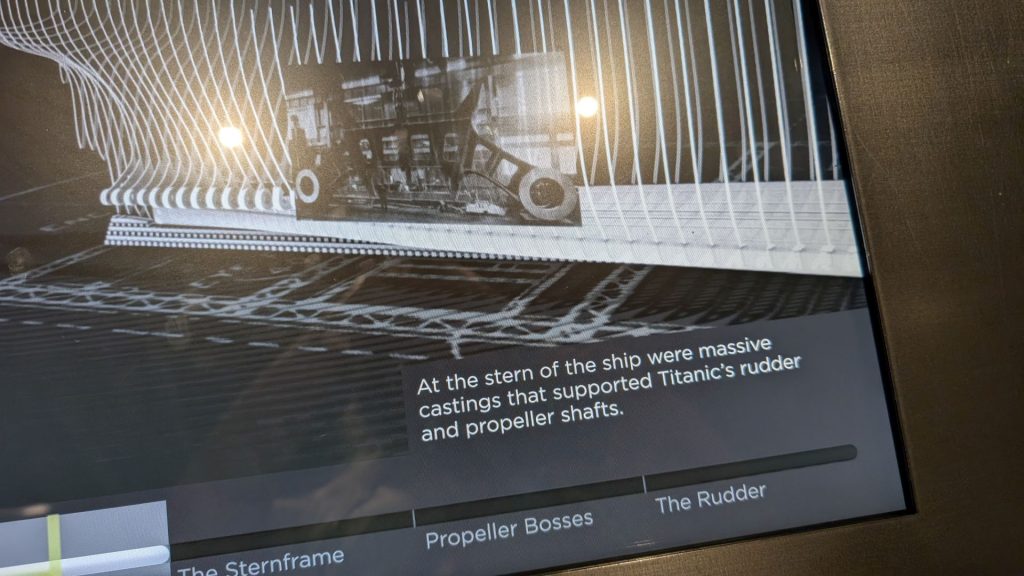


The Decks
As noted above, deck beams were attached to the frames at each deck level and cross-beams and supporting pillars were also added. The decks were arched, known as camber, so that any water would run to the channel waterway and drain overboard. The wooden decks were mostly laid in pine, and were secured to the steel plating beneath by bolts. The exterior decks were clad in yellow pine and caulked so they remained weatherproof.


Holding Titanic’s Skin in Place
The steel plates that made up Titanic’s hull were attached to her frame. They were mostly 30 feet long, six feet wide, one inch thick, and weighed over four tons.
Plates on the bottom of the ship overlapped each other like roof tiles in the clinker fashion. Plates at the side of the hull were alternately sunken and raised, known as inner and outer “strakes.”
The plating and other structural parts of the ship were held together with rivets. Good quality riveting was essential as it held the structure together.
The Interior
What was it like inside? You should probably watch the Titanic movie to get the best idea as there weren’t many pictures at The Titanic Experience.
I don’t recall whether they showed the boilers in the movie. Probably not. Titanic’s boilers were located on the orlop deck. (The orlop is the lowest deck in a ship, immediately above the hold. It is the deck or part of a deck where the cables are stowed, usually below the water line. The word derives from the Dutch overloop from the verb overlopen.) The 29 boilers were fed by coal-burning furnaces. The boilers drove the ship’s engines and electric generating plant.
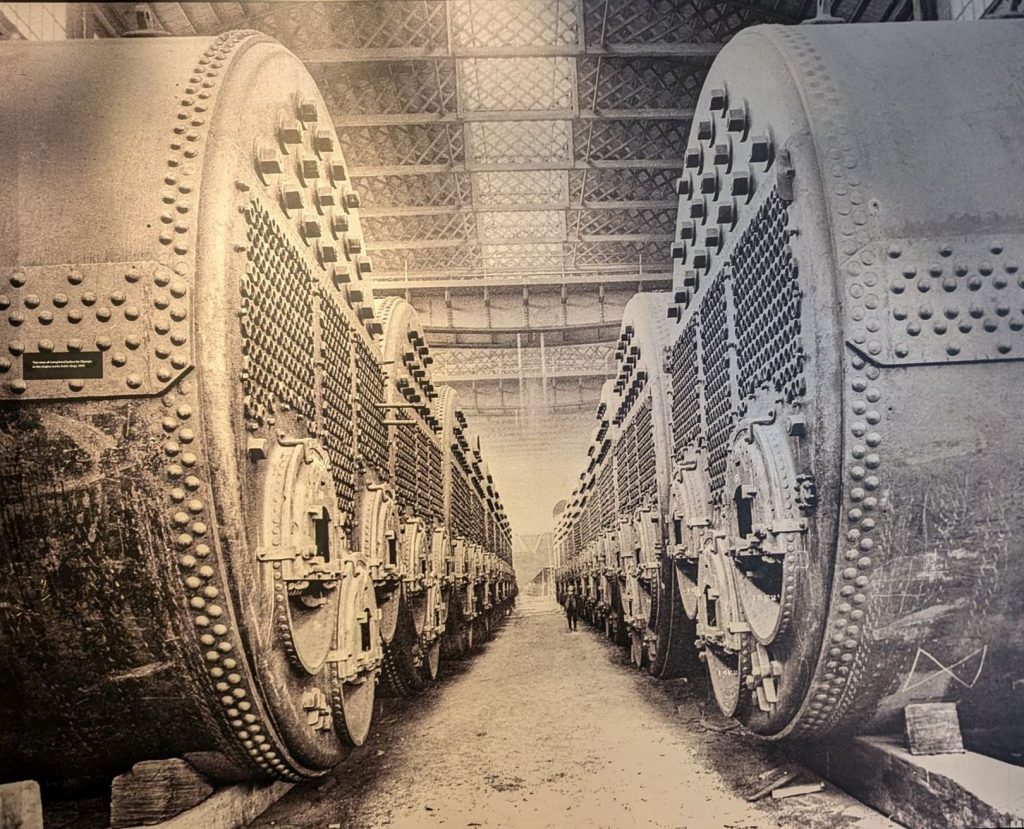
First Class
First class areas were very luxurious and were comparable with the best hotels of the time. Here is a reproduction of a First Class cabin:
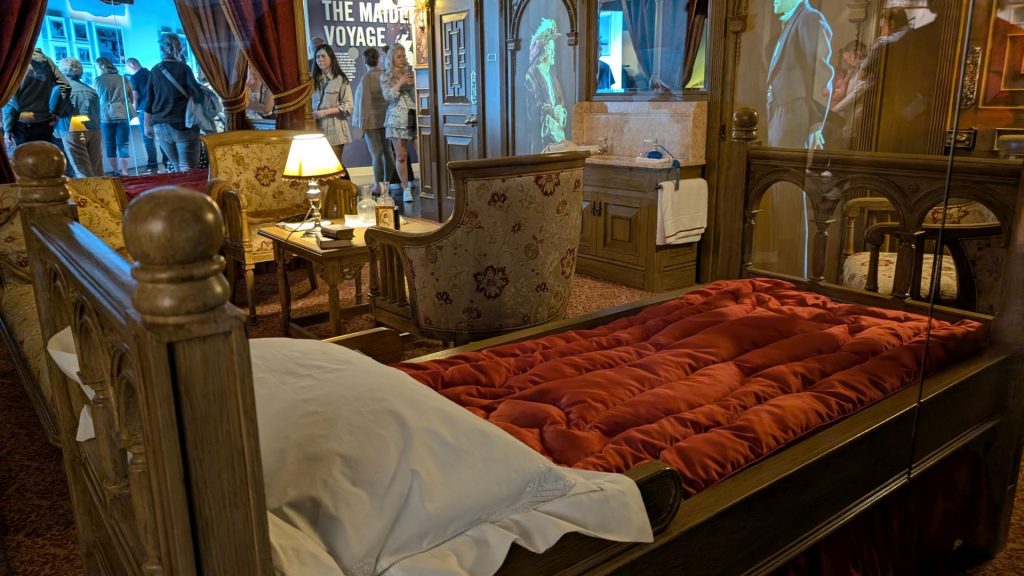
This particular cabin would have been occupied by extremely wealthy people such as members of the aristocracy or very successful business people.
The cabin was fitted with windows letting in natural light and electronic lights, including a portable table lamp, wall and ceiling lights. A wash basin was surrounded by rouge marble with a cabinet below. It also had an oak wardrobe on each side of the beveled mirrors and drawers. A lounge settee, table and chairs ensured that passengers could sit comfortably in their cabin.
Carved oak paneling and wallpaper coverings decorated the walls. Oak beams adorned the paneled ceiling and both bedsteads were also constructed from carved oak.
The cabin had shared private access to a bath and toilet and its own private wardrobe room. The room was also fitted with carpet, a heater, wall tidy, electric fan, notice frame and bell push to call a steward.
There were a huge variety of cabins available from which First Class passengers could choose. Prices were wide-ranging and depended on the style and size of the cabin. First Class fares started at £26 per person. Passengers could choose from one-, two-, three-, or four-berth cabins. If traveling in larger groups or families, passengers could hire suites with interconnecting doors.
But it wasn’t just the cabins that made First Class special. There were a range of amenities available including a choice of dining, sporting, exercise and leisure facilities. The dining saloon was decorated in early 17th-century Jacobean style with detailed ceiling plasterwork, oak furniture, and a piano. The walls and ceiling were painted white with decorations in relief. The room was extravagantly lit using 404 lightbulbs as well as benefiting from natural light. A variety of sizes of tables were installed, with chairs upholstered in light green leather.
For First Class passengers wishing to relax on deck, steamer chairs with woolen rugs could be hired at a charge of four shillings each.
But what about the sanitary fittings?
Glad you asked. Titanic had bathing and toilet facilities which rivaled contemporary hotels. Royal Doulton and Shanks provided most of the sanitary appliances.
Most passengers who bathed used public bathrooms. A limited number of private bathrooms were provided with First Class staterooms. Within Second and Third Class, all bathrooms were public, with only two bathrooms provided for all the Third Class passengers. (Ew!)
Public baths used hot and cold salt water. Fresh water shower sprays were provided only with First Class private baths and in the captain’s quarters.
Most cabins had wash basins fitted, with the exception of Third Class single male accommodation. Many First Class staterooms had Royal Doulton wash basins set in marble. Some First and Second Class washbasins could be folded away within a wash cabinet.
A limited number of private Royal Doulton manufactured toilets were available within First Class accommodations. Each passenger class had access to public free-standing flush toilets and accompanying washbasins. Royal Doulton urinals were fitted in all the men’s public lavatories.
Second Class
What did a Second Class cabin look like? I think they were still quite nice. Here’s an example:

Second Class cabins on the Titanic were as good as First Class cabins on other ships. This two-berth cabin was designed so it could be used for both Second and First Class passengers.
The cabin contained sleeping accommodation of a single mahogany bunk which was fitted with an upper Pullman berth above to provide another bed. The wardrobe was made from mahogany and had a mirror on the inside. An upholstered settee provided comfortable seating.
The single wash basin did not have hot and cold running water but had a reservoir which was filled by the bedroom steward. White paneling decorated the walls. For the comfort of passengers public toilets and baths were situated nearby.
As this cabin was also designed to be used by First Class passengers it contained a heater and was fitted with carpet. Other Second Class cabins were fitted with linoleum tiles of either red and white or green and white. Mahogany bunk beds were standard in most Second Class rooms which could be either two- or four-berth. Four-berth rooms generally had one set of bunk beds and a sofa bed that could be converted into two berths.
Second Class passengers would have been professional people such as doctors, engineers or highly skilled workers. Second Class ticket prices started at £9 13s 9d from Queenstown.
Second Class facilities included a dining saloon, promenade deck, smoke room and library. The dining saloon was decorated in Early English style utilizing oak and had decorative canopies above the doors. The room was lit naturally and with electric lights and contained 44 oak framed tables with red padded oak chairs as well as a piano.
Wallace Henry Hartley stayed in a Second Class cabin. He was the bandmaster of the saloon orchestra that entertained first and second-class passengers on board Titanic. As he was employed through an agency, and not directly by White Star Line, he was accommodated in a Second Class cabin.
The Band Played On
Shortly after Titanic disastrously struck an iceberg on April 14th, the ship’s musicians were called upon to play in the first-class lounge, to calm and reassure the passengers. As the ship began to sink, they performed on the boat deck as passengers and crew were loaded into lifeboats. The quote by Second Officer Lightoller (below) confirms that the music was helpful.
After the sinking, Wallace and the other musicians were declared heroes. His violin and its case were recovered, and are now considered some of the most valuable artifacts of the Titanic Story.

Speaking of music, Titanic carried six pianos: three in First Class, two in Second Class and one in Third Class. The pianos for First and Second Class were supplied by the German firm of Steinway & Sons.
Third Class
This is a picture of a Third Class cabin. Sorry for the reflection.

Third Class cabins on Titanic were basic compared to First and Second Class accommodation but were a massive improvement from the large dormitories on other ships.
The cabin contained a double bunk made from mahogany with pillows and sheets provided. The room had a washbasin with a mirror above and a wall seat. Red litosilo covered the floor and the walls were covered in white paneling. Passengers would have had to go up two decks to reach the public toilets from this cabin.
[Harding’s Litosilo was a patented deck-sheathing (sub-flooring) for marine use, common back in the early 1900s. It was used in several areas aboard the RMS Titanic and Olympic. A scene in the 1997 Film Titanic depicts a group of Third Class passengers ripping up a bench from the Litosilo to destroy a gate.]
Other Third Class accommodation on board included two-, three-, four-, five-, six-, eight- and ten-berth cabins. Cheaper, more basic accommodation, without wash basins, with lower quality mattresses and no pillows was available for single men. Other cabins were designed with families or single women in mind. No single berth accommodation was available for Third Class passengers.
The majority of Third Class passengers were emigrants heading to America for a better life. Therefore they would generally have been going on a one way ticket. Third Class passenger occupations would have included laborers, servants, unskilled and semi-skilled workers. The cost of a Third Class ticket started at £6 15s from Queenstown to New York. This was equivalent to almost a month’s wages for skilled Harland and Wolff workers.
Third class public areas were basic but superior to those on most other ships at the time. Facilities included a dining saloon, smoke room, general room and promenade. The dining saloon was divided into two; one section was for single women and families, the other for single men. Each room had tables seating up to 14 people with swivel chairs. The white walls were partially paneled and partially exposed steel and were used to hang advertising posters.
The main reason I would not have wanted to have been a Third Class passenger was because I wouldn’t have wanted to undergo the final medical examination. Before boarding, Third Class passengers were subject to the Button Hook exam. Using a ladies button hook every immigrant had their eyelid turn back on itself. The doctor undertaking this procedure was looking for any traces of the highly contagious eye disease trachoma.
This is a picture of the hook and the Inspection Card.
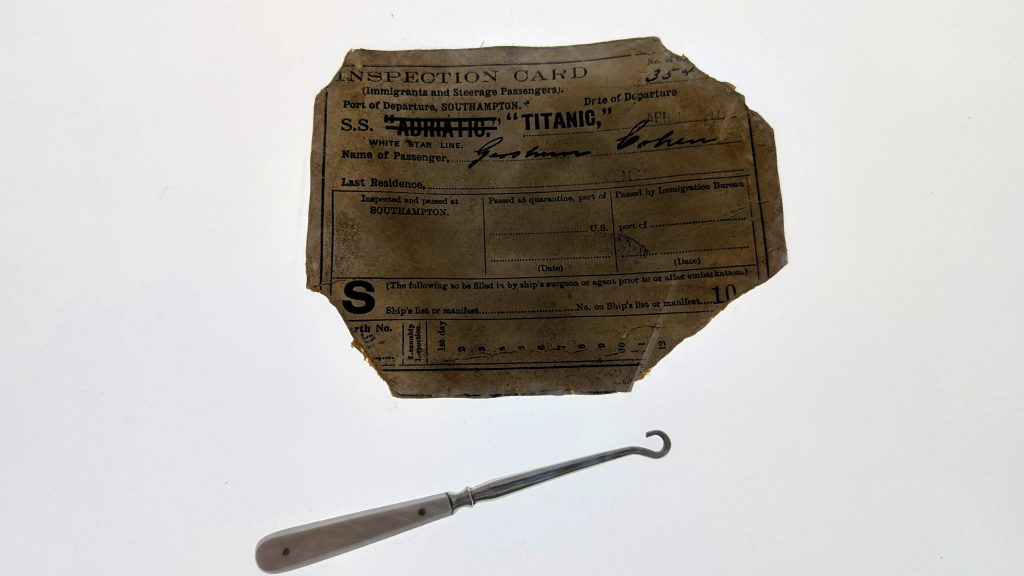
Crew
Titanic could accommodate 945 crew members. There were many different working areas and crew accommodation areas on board.
Titanic had three departments of crew who were essential for the journey. The deck department steered and navigated the ship. This included Captain Smith, bridge officers and seamen. The engine department was in charge of the propulsion machinery. Crew such as engineers, firemen and electricians worked in the engine department. The victualling department was the largest and served passengers – stewards made up the greatest number in this department.
There was a hug variety of crew accommodation depending on their rank. The chief engineer had a well-furnished bedroom and sitting room and access to his own bathroom. Other more junior crew members, such as firemen, would have shared dormitory rooms. There were also different washing and eating areas for different types of crew.
With over 3000 mouths to feed, food storage, preparation, cooking and serving was a major responsibility of the victualling department. Titanic had several kitchens on board to feed staff and crew. The kitchens were divided into sections dealing with different foodstuffs while the pantries and stores carried huge quantities and varieties of food and drink. The kitchens were equipped with the best up-to-date gadgets available.
Navigation and Communication
The Titanic carried a huge range of navigating equipment to help steer the ship in the right direction. Four main compasses were located at various positions on the ship. A variety of other nautical equipment calculated the position of the ship, distance traveled, speed and depth of water.
The Titanic had three wheels for steering. The main wheel was located in the wheelhouse. Besides the main wheel, the helm indicator showed the position of the rudder. Telegraphs conveyed messages from the navigation bridge.
Titanic carried barometers and thermometers for predicting the weather. Clinometers were used to indicate the angle of roll or pitch. Titanic’s equipment could pick up underwater bell signals from lighthouses, buoys and other ships, which warned of dangers such as fog. The ship also used a range of sextants, telescopes, megaphones, foghorns, log books, diaries, navigational charts, and binoculars.
Lighting included masthead lamps, sidelights and anchor lights. For communicating with other ships Titanic used the Marconi wireless, flags, signal lamps (which flashed lights in Morse code to signal other ships at night) flares and rockets.
Titanic’s powerful Marconi wireless equipment allowed her to communicate with stations more than a thousand miles away. The wireless was manned around the clock and was operated using Morse code. This equipment allowed the ship to both send and receive messages. The Marconi operators communicated shipping messages and personal messages for passengers. News received via the wireless was printed in an on-board newspaper.
The Launch
Titanic was launched on May 31, 1911. Her maiden voyage wasn’t until April 10, 1912. The delay between the Titanic’s launch and maiden voyage was primarily due to the extensive “fitting out” process required to complete the ship’s interior and systems (which we have been describing above), including elaborate woodwork and decor, which took considerable time; additionally, a collision by the sister ship, Olympic, further delayed the Titanic’s maiden voyage as the shipyard needed to prioritize repairs on the Olympic first.


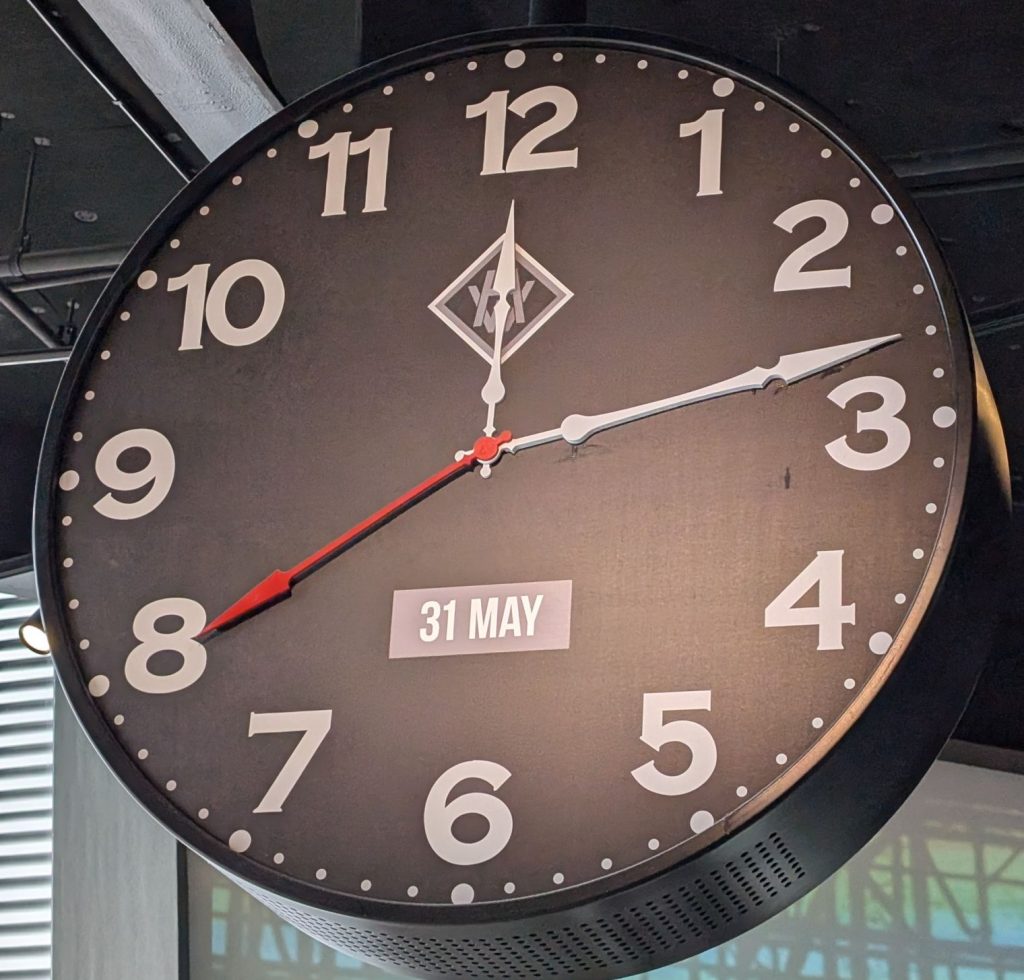

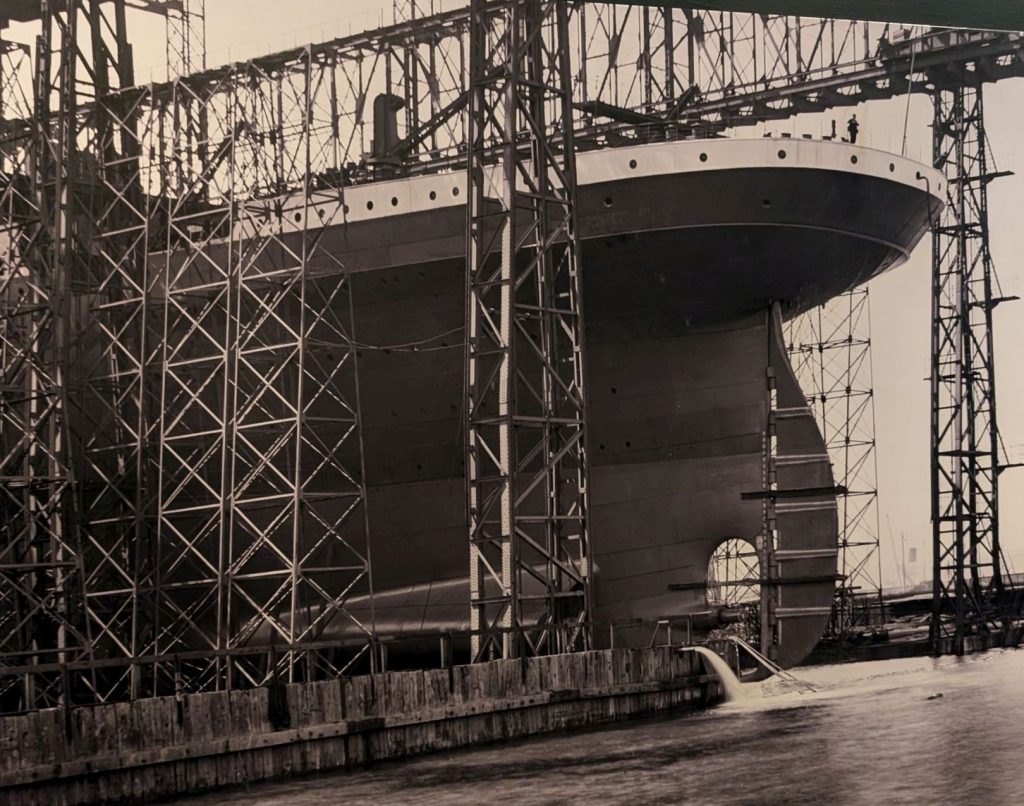
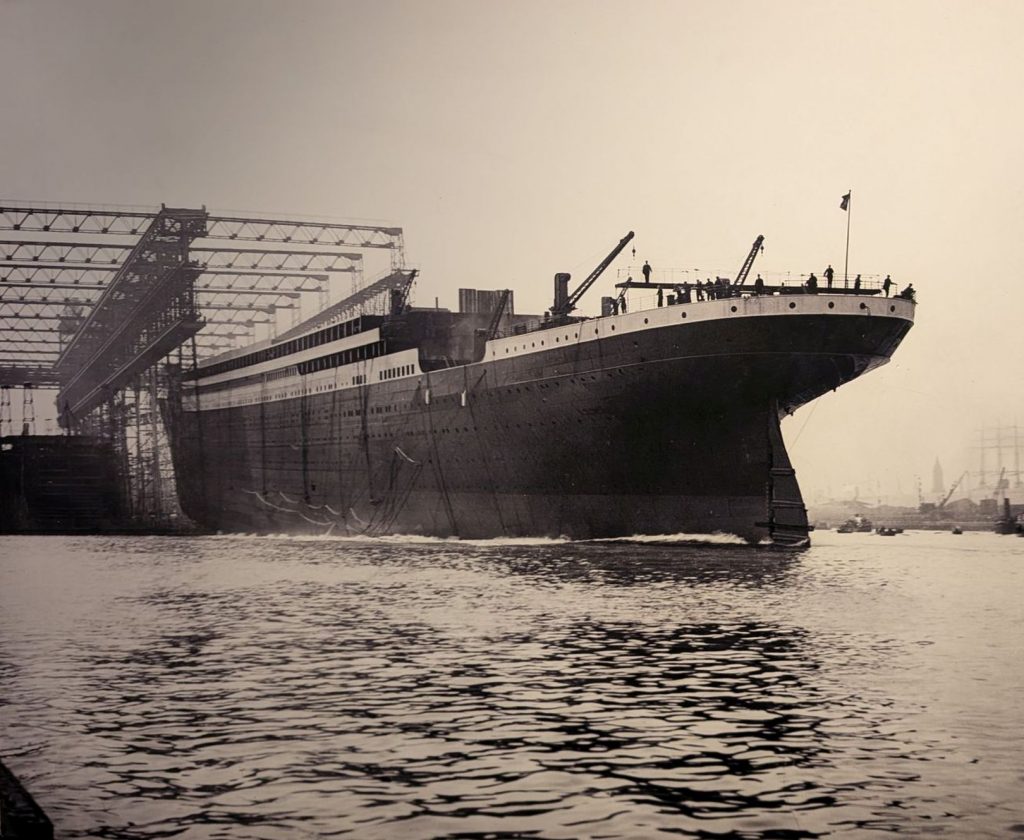
Fast forward about a year
Titanic left Belfast on April 2, 1912 and began her maiden voyage April 10, 1912. She struck an iceberg at 11:45 a.m. on April 14, 1912.

Final Communications
One of the most moving and horrifying items on display were records of the final communications between Titanic and other ships as Titanic was in trouble. I will share them in order.

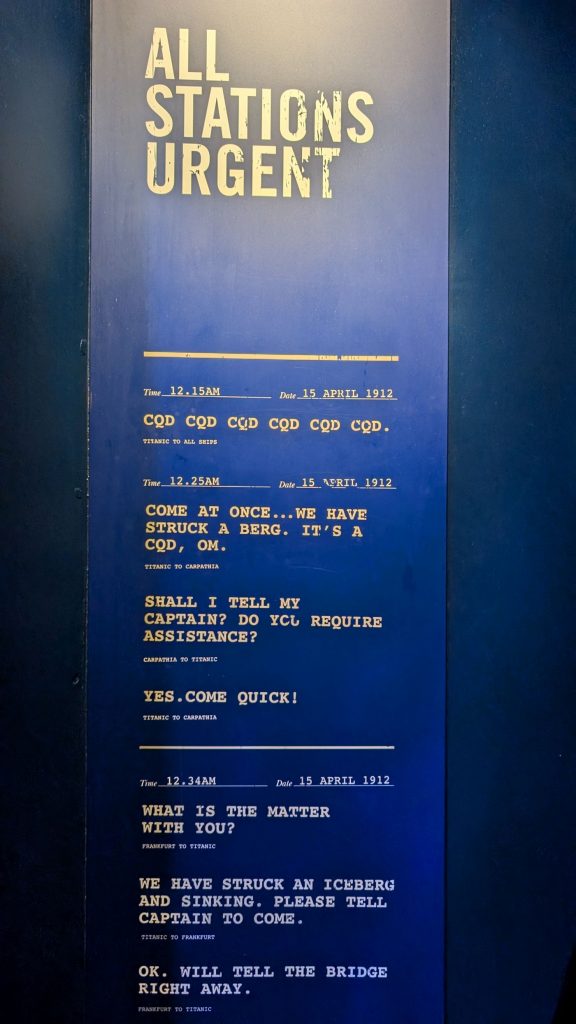



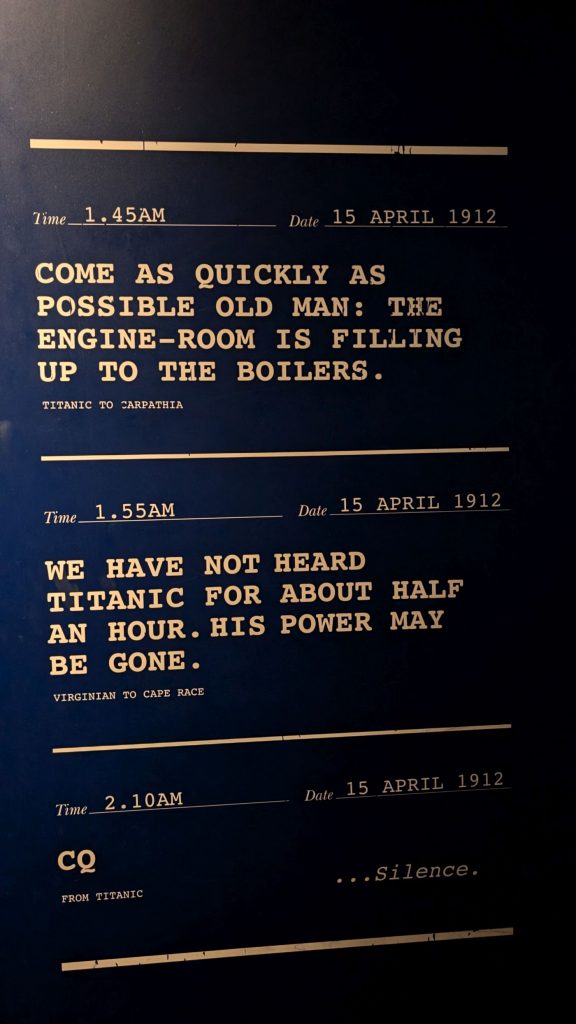
Rescue and miscommunication
Carpathia was the first ship to reach the scene of the disaster. Based on what was shared at the exhibit (below left), the captain did a stellar job in rescuing and caring for the surviving passengers (and burying the four who died at sea).
Sadly, misinformation began spreading quickly. This must have added significantly to the angst of family and friends eager to hear of the welfare of the passengers.
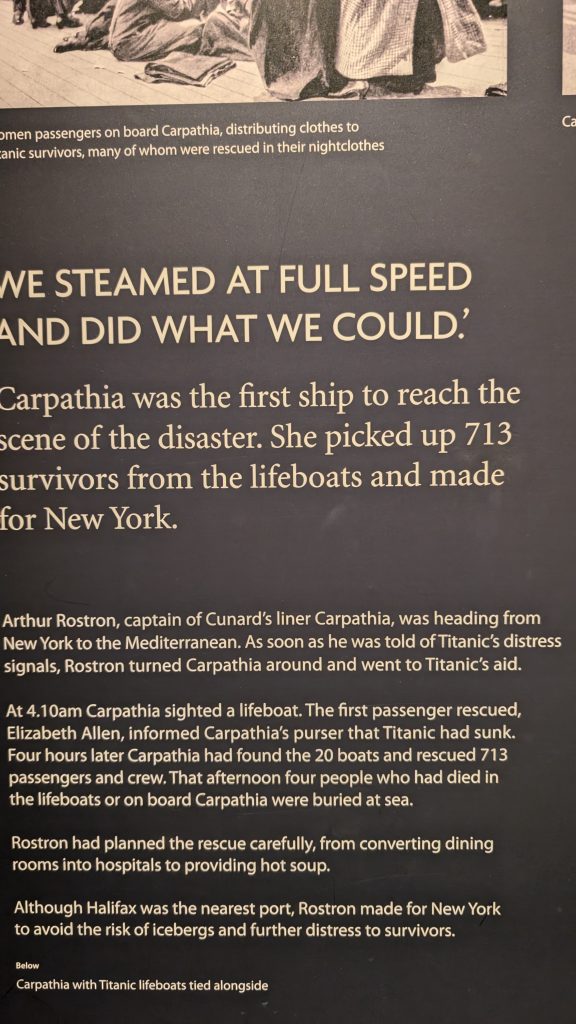

It was several days before the full extent of the tragedy was revealed.
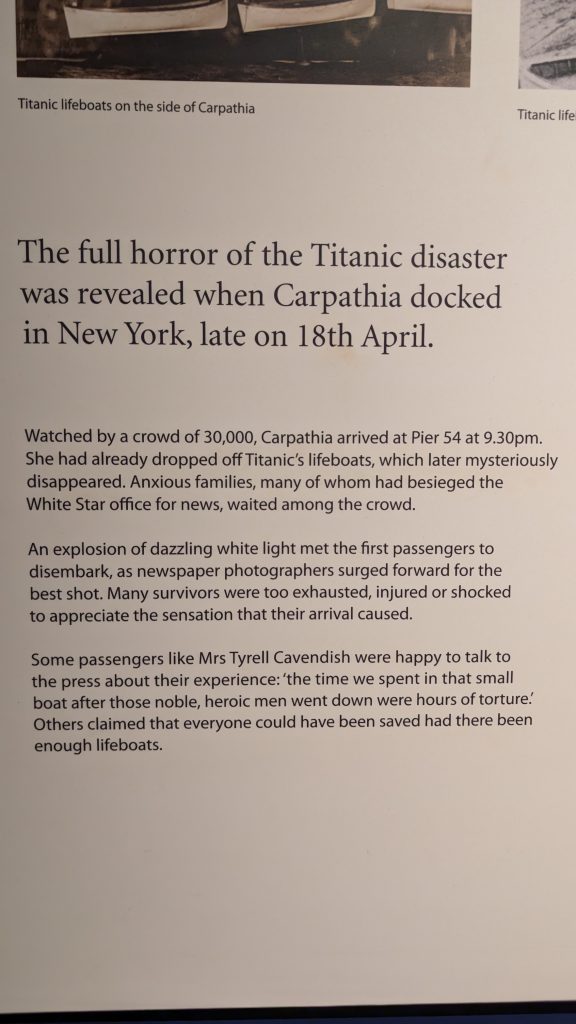
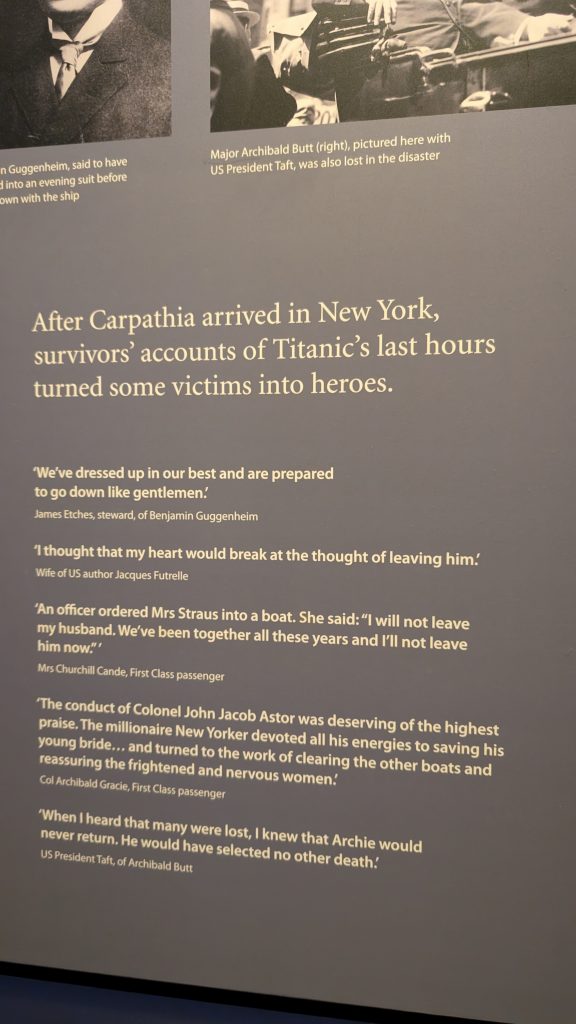
Some of the passengers
The exhibit displayed information about several of the passengers. I think it was to personalize it for the visitors.


First Class Passengers:



Second Class Passengers:

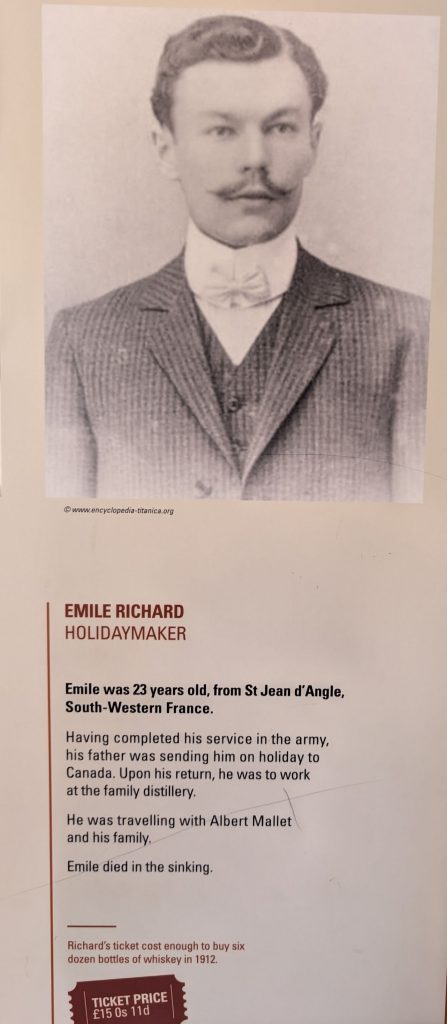

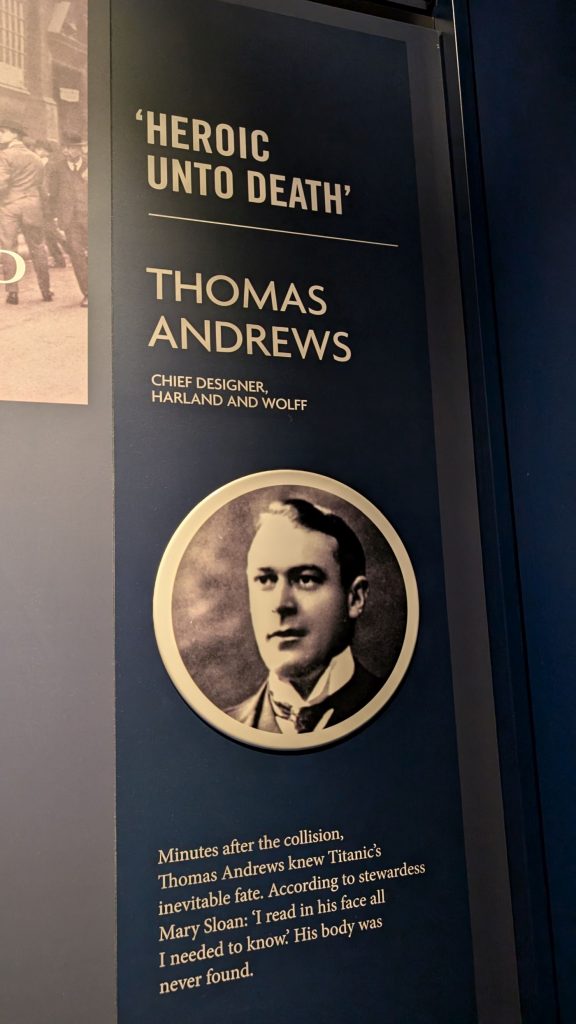
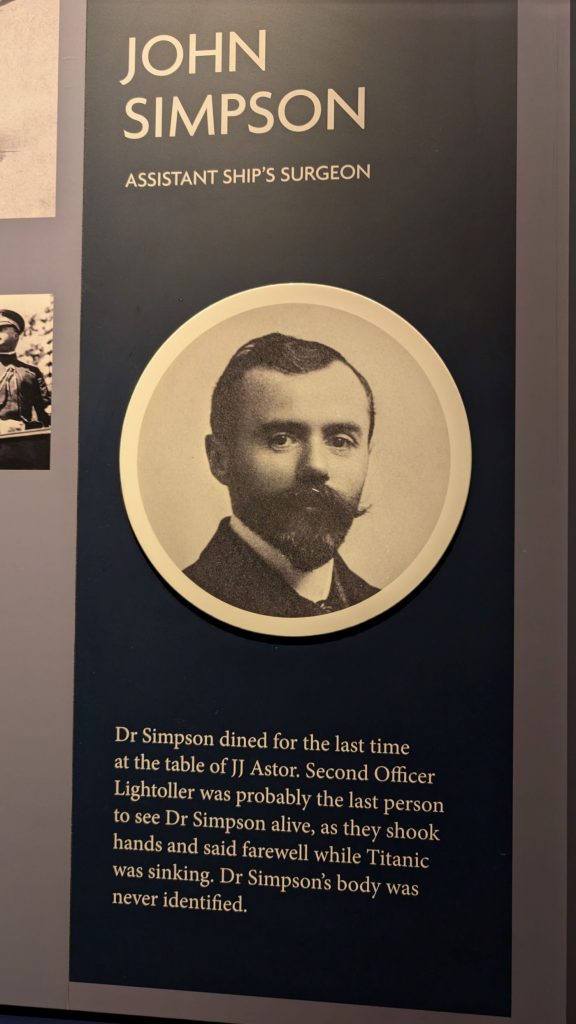
And this:
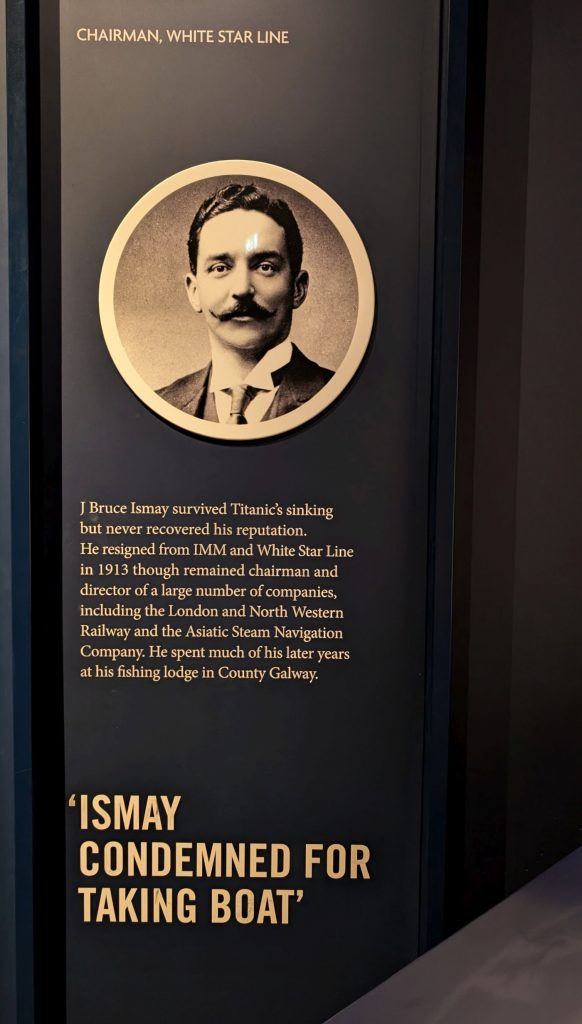
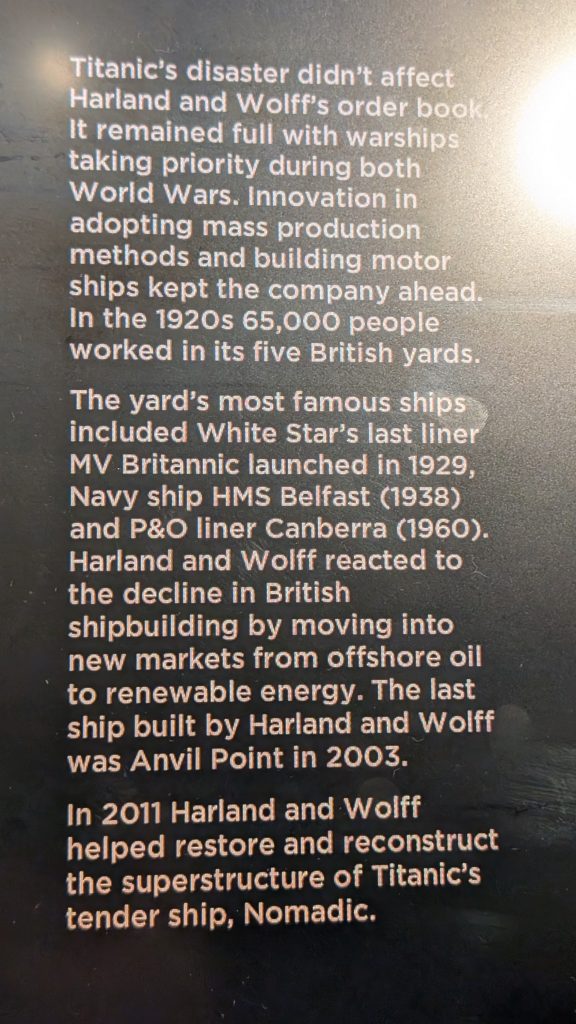
If reading about the number of deaths and individual passengers didn’t tug on your heartstrings enough, the last things we saw were statistics about the numbers of lives saved and lost (see “Humanity facts” below) and this 3-D exhibit. It is a replica of the Titanic. It is constantly rotating as the ship’s lights change, indicating activity on board. Of course, it doesn’t break into two, but when the final lights are extinguished, you know it is representing her loss to the sea. It is accompanied by music and surrounded by videos. These pictures don’t do it justice, but they give you an idea.
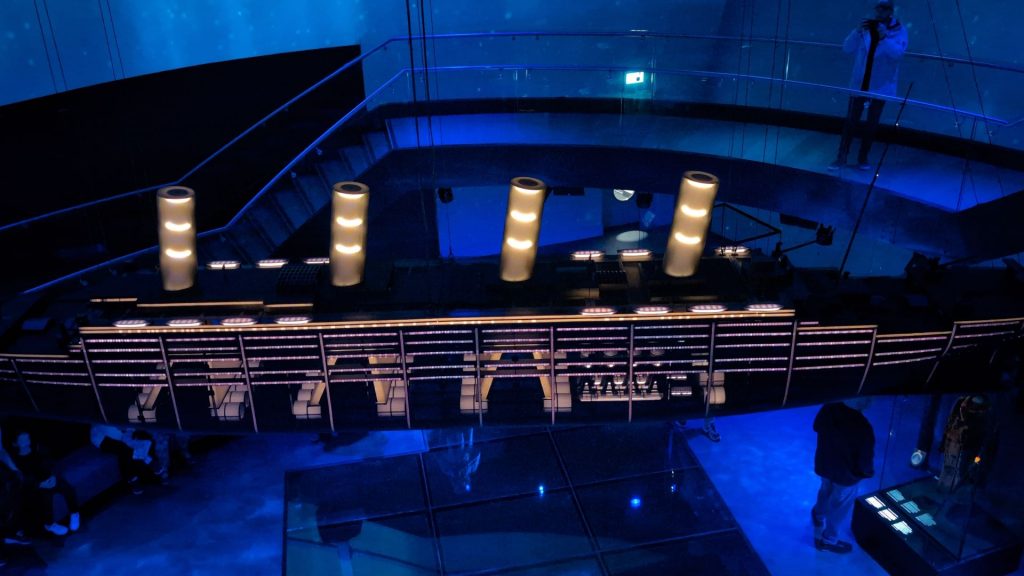

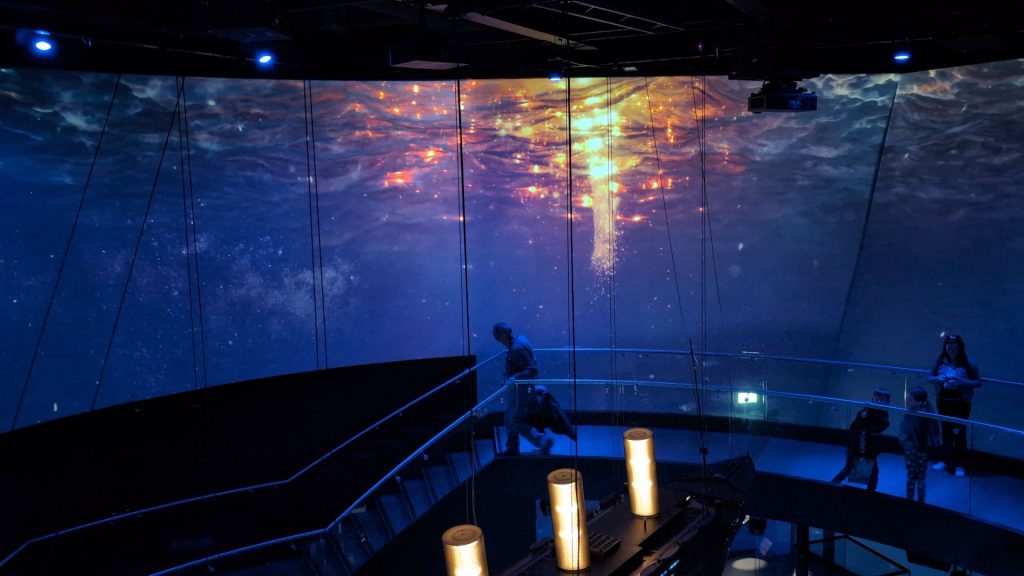

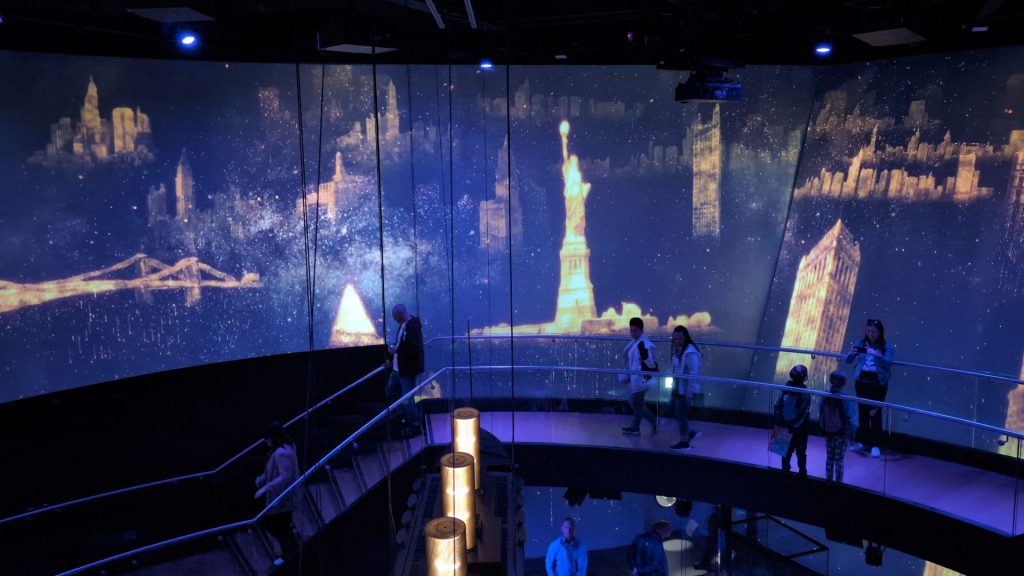



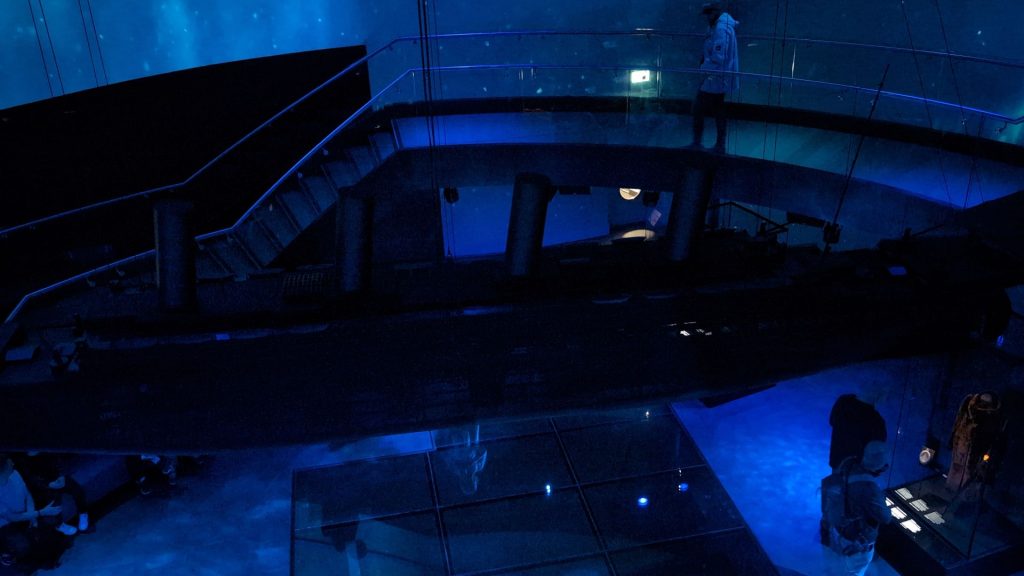
Other facts:
— There were 254 recorded accidents with eight fatalities during the construction of Titanic.
— Approximately 3,000 of Harland & Wolff shipbuilders constructed the Titanic. This was about 20% of the total Harland & Wolff workforce.
— 26 months was the length of time it took to build the RMS Titanic, from keel to launch.
— 20 horses were needed to transport the main anchor.
— The average number of hours worked per week at the shipyard was 49 (six days/week).
— The weekly wage of a Harland & Wolff construction worker was £2.
— As there were no facilities on board to wash linen, Titanic needed to carry all of the linen for the voyage with her. This included 45,000 table linens and 18,000 bed sheets.
Humanity facts:
— 325 First Class passengers. 62% were saved.
— 285 Second Class passengers. 41% were saved.
— 709 Third Class passengers. 25% were saved.
— 1303 passengers. 38% were saved.
— 922 crew members. 23% were saved.
— 2225 people were on board. 32% were saved.
— The average age of those saved was 29.
— The oldest person saved was Mary Eliza Compton. She was 64.
— The youngest person saved was “Millvina” Dean. She was two months old.
— There were 12 dogs on board. Three were saved.
— The sinking of the Titanic was one of the deadliest civilian maritime disasters.
— Given the number of lifeboats, 53% could have been saved.
— 20 lifeboats were on board. 18 were launched.
— 2 collapsible lifeboats floated off the deck.
— 472 lifeboat seats were unused.
— Lifeboat No. 1 had a capacity of 65 but was launched with only 12 people.
— More women and children were saved than men.
— 435 women were on board. 75% were saved.
— Of the 144 women in first class 97% were saved.
— 87% of the female crew were saved.
— 124 children under the age of 15 were on board. 51% were saved.
— 1690 men were on board. 20% were saved.
— First Class passengers were saved at the highest rate due to their proximity to the upper decks.
Let’s end with this:
Why did the Titanic sink?
Yeah, she hit an iceberg. But did it happen the way the movie portrayed it? Did it tear a huge gash in the hull? Not according to this article (this was not at The Titanic Experience, I found it as I was writing this post):
It is now believed that it is the rivets that were the cause of the sinking.
From the National Institute of Standards and Technology (NIST): “Numerous research investigations since that time have pieced together the details of what occurred on April 14-15, 1912, after the Titanic struck an iceberg, broke in half and carried more than 1,500 people to their deaths. One of the most elusive questions—Why did the 41,730-metric ton (46,000-short ton) ship sink in less than three hours?—was answered in 1998 by NIST metallurgist Tim Foecke. The suspected culprit was one of Titanic’s smallest components—the 3 million wrought iron rivets used to hold the hull sections together.
Foecke performed metallurgical and mechanical analyses on steel and rivet samples recovered from the Titanic debris field at the bottom of the ocean. His examinations determined that the wrought iron in the rivets contained three times today’s allowable amount of slag (the glassy residue left behind after the smelting of the iron ore). The slag made the rivets less ductile and more brittle than they should have been when exposed to very cold temperatures—like those typically found in the icy seawater of the North Atlantic. This finding strongly suggested that Titanic’s collision with the iceberg caused the rivet heads to break off, popped the fasteners from their holes and allowed water to rush in between the separated hull plates.
Helping support the rivet theory are two bits of supporting evidence. First, sonar mapping of Titanic’s starboard hull buried in the ocean floor revealed only six thin tears from the iceberg with a total area open to the sea of only one square meter (12 square feet), or less than that of two sidewalk squares. This dispelled the long-believed myth that the iceberg ripped a 90-meter (300-foot) gash in the side of the ship. The actual damage could not have resulted in the flooding that overwhelmed Titanic’s watertight compartments.
Secondly, photographs of Titanic’s sister ship, the RMS Olympic, taken after it collided with another vessel in 1911, clearly show dozens of vacant holes in the hull from which rivets popped.”
That’s kind of a sad note on which to end. I am instead going to share a few more pictures from our walk back to the hotel and our stop at a pub.


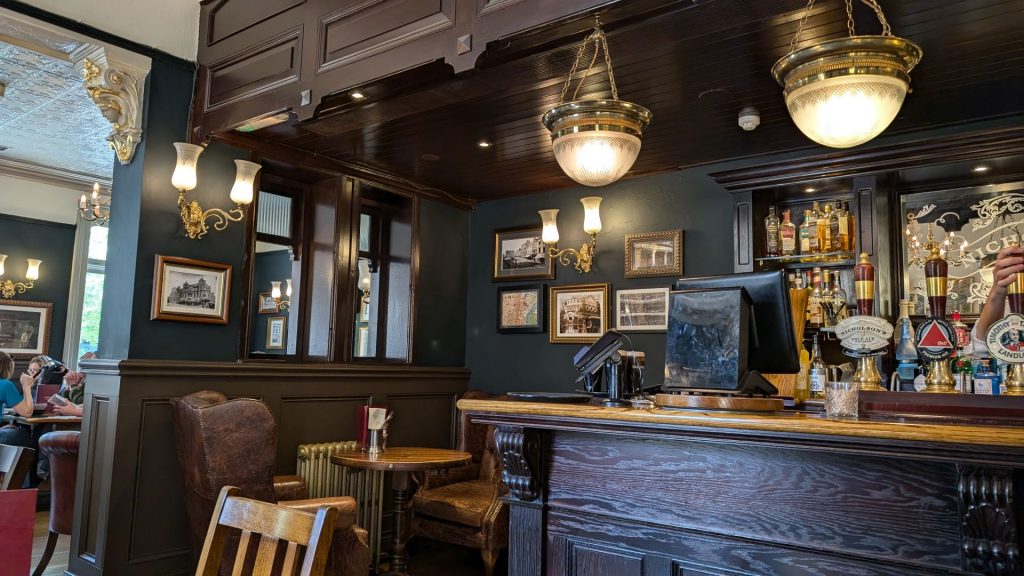
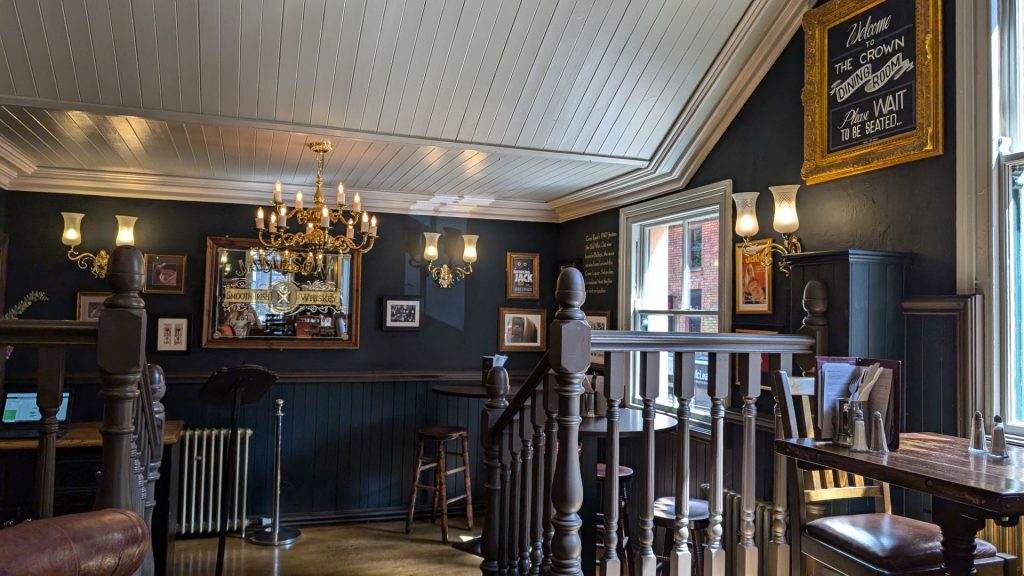


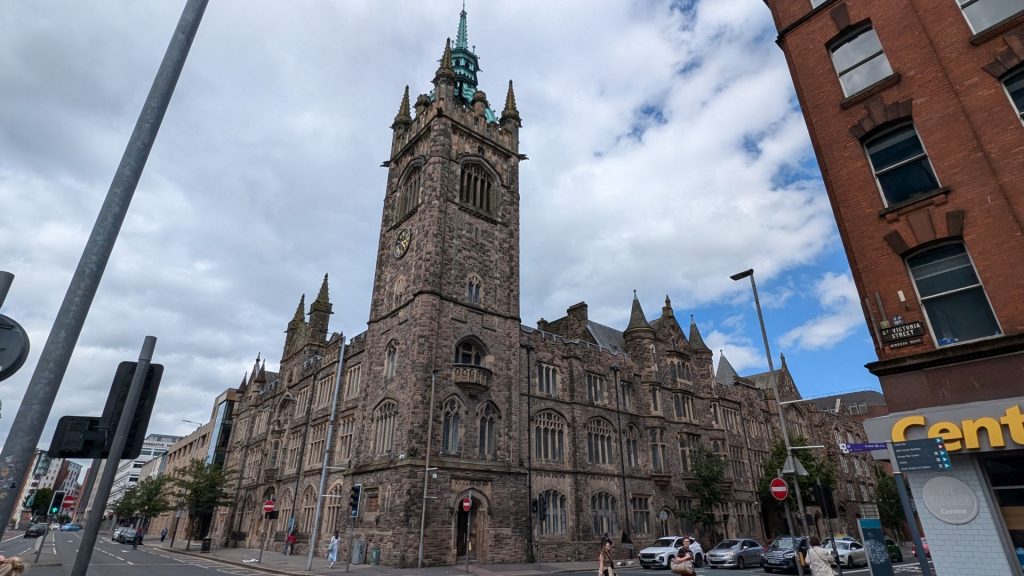

CHEERS!

